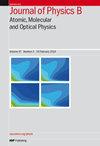高能原子碰撞中的辐射能传输电离与撞击电离
IF 1.5
4区 物理与天体物理
Q3 OPTICS
Journal of Physics B: Atomic, Molecular and Optical Physics
Pub Date : 2024-08-21
DOI:10.1088/1361-6455/ad6b64
引用次数: 0
摘要
我们探索了轻原子粒子高速(但尚未达到相对论)碰撞中的电离机制,其中一个粒子最初处于激发的内部状态。该机制由广义布赖特相互作用驱动,通过碰撞粒子之间的辐射能量传输进行,其传输距离极长。将这一机制与高速碰撞的 "标准 "机制进行比较后发现,它在与激发目标原子的碰撞中可以发挥明显的作用。本文章由计算机程序翻译,如有差异,请以英文原文为准。
Ionization by radiative energy transport vs. impact ionization in energetic atomic collisions
We explore a mechanism for ionization in high-velocity (but not yet relativistic) collisions of light atomic particles, one of which being initially in an excited internal state. This mechanism is driven by the generalized Breit interaction and proceeds via radiative energy transport between the colliding particles which has an extremely long range. A comparison of this mechanism with those which are ‘standard’ for high-velocity collisions shows that it can play a noticeable role in collisions with excited target atoms.
求助全文
通过发布文献求助,成功后即可免费获取论文全文。
去求助
来源期刊
CiteScore
3.60
自引率
6.20%
发文量
182
审稿时长
2.8 months
期刊介绍:
Published twice-monthly (24 issues per year), Journal of Physics B: Atomic, Molecular and Optical Physics covers the study of atoms, ions, molecules and clusters, and their structure and interactions with particles, photons or fields. The journal also publishes articles dealing with those aspects of spectroscopy, quantum optics and non-linear optics, laser physics, astrophysics, plasma physics, chemical physics, optical cooling and trapping and other investigations where the objects of study are the elementary atomic, ionic or molecular properties of processes.

 求助内容:
求助内容: 应助结果提醒方式:
应助结果提醒方式:


